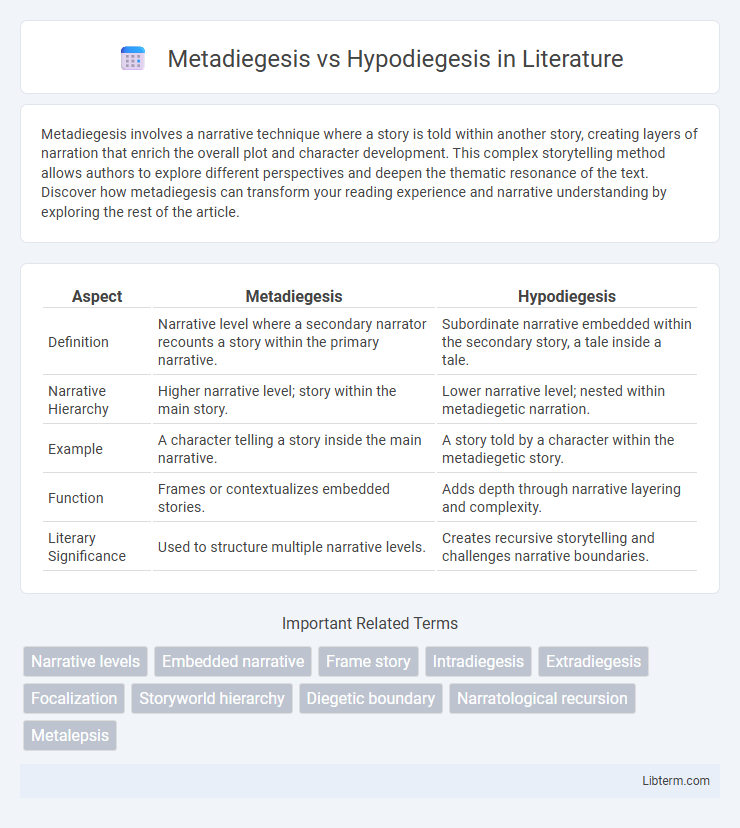Metadiegesis involves a narrative technique where a story is told within another story, creating layers of narration that enrich the overall plot and character development. This complex storytelling method allows authors to explore different perspectives and deepen the thematic resonance of the text. Discover how metadiegesis can transform your reading experience and narrative understanding by exploring the rest of the article.
Table of Comparison
| Aspect | Metadiegesis | Hypodiegesis |
|---|---|---|
| Definition | Narrative level where a secondary narrator recounts a story within the primary narrative. | Subordinate narrative embedded within the secondary story, a tale inside a tale. |
| Narrative Hierarchy | Higher narrative level; story within the main story. | Lower narrative level; nested within metadiegetic narration. |
| Example | A character telling a story inside the main narrative. | A story told by a character within the metadiegetic story. |
| Function | Frames or contextualizes embedded stories. | Adds depth through narrative layering and complexity. |
| Literary Significance | Used to structure multiple narrative levels. | Creates recursive storytelling and challenges narrative boundaries. |
Understanding Diegesis: A Narrative Foundation
Metadiegesis and hypodiegesis represent layered narrative techniques within diegesis, where metadiegesis refers to a story within a story told by a character, and hypodiegesis involves a subordinate narrative embedded in the main diegesis. Understanding diegesis as the core narrative framework enables deeper analysis of how these nested stories function to enrich plot complexity and character perspective. This narrative foundation clarifies the distinction between primary storytelling and secondary or embedded narratives, essential for interpreting multi-layered literary and cinematic texts.
Defining Metadiegesis and Hypodiegesis
Metadiegesis refers to a narrative layer in which a story is told within another story, creating a self-reflexive or embedded narrative structure. Hypodiegesis denotes a subordinate narrative embedded within the primary narrative, often serving as a story-within-a-story that provides context or background. These concepts analyze complex storytelling techniques where multiple narrative levels coexist to enrich the overall plot.
Structural Differences in Metadiegetic and Hypodiegetic Narratives
Metadiegesis involves a narrative level where a story is embedded within another narrative, creating a layered structure where the secondary narrative comments on or expands the primary one. Hypodiegesis, on the other hand, refers to subordinate or embedded narratives that are part of the main narrative but serve as background or illustrative episodes without independent narrative autonomy. Structural differences are evident as metadiegetic narratives maintain a distinct separation between narrative levels, often with a framing narrator, while hypodiegetic narratives are more seamlessly integrated into the host narrative, lacking a clear narrative boundary.
Functions of Metadiegesis in Storytelling
Metadiegesis functions as a narrative layer where a story is embedded within another story, enabling storytellers to explore complex perspectives and deepen thematic elements. It allows characters to recount events or experiences, enriching the plot with subjective interpretations and multiple realities. This narrative technique enhances storytelling by creating a dynamic interplay between the primary narrative and the embedded tale, fostering greater engagement and interpretive depth.
The Role of Hypodiegesis in Narrative Depth
Hypodiegesis enhances narrative depth by introducing embedded stories that provide multiple layers of meaning and complexity within the primary narrative framework. This technique allows audiences to explore subplots and character perspectives, enriching the overall storytelling experience without interrupting the main diegesis. By creating a story within a story, hypodiegesis fosters immersion and deeper engagement with the narrative's thematic and emotional dimensions.
Examples of Metadiegesis in Literature and Film
Metadiegesis appears prominently in literature and film through narratives that unfold stories within stories, such as the frame narrative in Geoffrey Chaucer's "The Canterbury Tales," where pilgrims recount various tales. Film examples include "Inception" directed by Christopher Nolan, which features layered dream sequences functioning as embedded narratives within the main storyline. These instances exemplify metadiegesis by establishing self-contained narrative worlds inside a broader diegetic context, enriching the complexity of storytelling and engaging audiences in multi-level interpretation.
Hypodiegetic Narratives: Case Studies and Analysis
Hypodiegetic narratives present stories embedded within a primary narrative, often appearing as dreams, letters, or tales recounted by characters, enriching the main plot with layered meanings. Case studies like nested storytelling in "One Thousand and One Nights" and the ghost stories in "Wuthering Heights" illustrate the technique's capacity to deepen character development and thematic complexity. Analytical frameworks reveal hypodiegesis as a crucial tool for exploring subjectivity, unreliable narration, and metafictional commentary in literary texts.
Reader Immersion: Effects of Narrative Layers
Metadiegesis introduces a secondary narrative layer where a character within the story recounts another story, enriching reader immersion by creating complex narrative depth. Hypodiegesis occurs when the embedded narrative is presented as a direct, self-contained story within the primary narrative, streamlining reader engagement through straightforward storytelling. The interplay between metadiegetic and hypodiegetic layers enhances the reader's experience by fostering a multifaceted understanding of events and characters.
Interplay Between Metadiegetic and Hypodiegetic Elements
Metadiegesis involves a narrative framework where stories are embedded within the primary narrative, creating a layered storytelling technique that enriches the reading experience through multiple narrative levels. Hypodiegesis, as a subordinate story within the diegesis, operates as an internal narrative that adds depth and complexity, often revealing characters' motivations or background. The interplay between metadiegetic and hypodiegetic elements enhances narrative complexity by allowing embedded stories to influence the main narrative's meaning and perspective, creating a dynamic interaction between the different narrative strata.
Conclusion: The Significance of Narrative Leveling
Metadiegesis and hypodiegesis illustrate critical distinctions in narrative layering, where metadiegesis denotes a story within a story that exists at a higher narrative level, while hypodiegesis refers to a subordinate embedded narrative. Understanding these concepts enhances the analysis of complex storytelling structures by revealing how narrative levels interact and influence the reader's perception and interpretation. The significance of narrative leveling lies in its ability to deepen engagement, enrich meaning, and provide a multifaceted experience within literary and cinematic texts.
Metadiegesis Infographic

 libterm.com
libterm.com